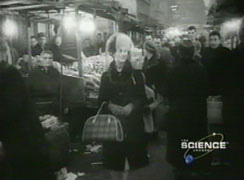Home / / Photo / Sculptures / Curatorial Projects / Bio / Contact
|
Audition Starring CFOXC |
The Coop Kenya Demo Derby |
Corviale Three things The Romanians |
The Mystery of God Mexico 68 |
bitches brew under over sideways fear chamber |
Friday market Za Zelazna Brama |
||||||
“Exposed” is the cinematic portrait of a young woman named Katherine Devoir, a woman who, due to the illness Multiple Chemical Sensitivity, has dropped completely out of normal societal structures. Heidrun Holzfeind visited and interviewed Katherine several times at her house in Western Massachusetts. From this exchange emerges an essay-like video documenting the development of the protagonist’s illness and her respective environments over a longer period of time. “Exposed” expands greatly on the traditional production methods for documentary film. The artist uses various source materials, combining found footage with taped interviews and Hi8-video sequences taped by Katherine herself.These varying source materials, carefully selected musical score, and the protagonist's voiceover interact on many levels: visually, textually and tonally. In contrast to classical documentary discourse, which champions the authorizing index-icality documentation, “Exposed” uses both documentary and autobiographical material, leading to a subjective/objective form of contextualization. The narrative voice of Katherine andher omnipresence in the varying source materials are centrally characteristic to the piece. The video begins with a sequence of found footage commercials from the 50s and 60s, glorifying the invention of new substances and synthetic materials. Consumer products like plastic utensils, hairspray, or toothpaste - and their new industrial fabrication techniques - promise economic boom, simplification of everyday life, and - thanks to the seemingly unlimited possibilities of this new product world - the liberty to create your own individualized “modern” existence. These short clips illustrate the values of capitalism, where technical and chemical “innovations” symbolize the utopia of a better world due to the concurrent progress of economic and social prosperity. The intrinsic message is pointed at the individual that keeps this world alive, as well as that is “profiting” from it. Accordingly, a commercial voice over slogan states: “The world of the molecule belongs to us all. It is yours to explore.” What was conceived as a sensation a few decades ago has become normality today. The advertising industry continues to promote new variations of products, which promise the buyer image improvement and stress relief in everyday life. Thanks to ecological studies and health trends, these advertisements aren’t understood as one-dimensionally as they were back then, but still it can be said that the basic demand for and use of synthetically produced products - and the inherent environmental pollution that goes along with them - exists unchallenged and is accepted as normal. Against this backdrop, the protagonist of “Exposed” is introduced: Katherine Devoir, a 35-year-old American dancer, suffering from Multiple Chemical Sensitivity (MCS). MCS is a chronic illness caused by massive or long-term exposure to toxins. Characteristic of the illness is that it is extremely detrimental for the ill person to come into contact withchemically produced substances - such as pesticides, perfume, building materials, carpets, paints, cleaning agents, exhausts, air conditioning, tobacco smoke, or food additives - as the contact causes massive malfunctioning of multiple bodily systems. Katherine stands in front of her house in the middle of the woods and introduces herself, “My name is Katherine and this is where I live. I live here since three years. Before that I spent twelve years in New York. Before I got sick, I was like normal. I could do anything I wanted.” Following are home videos and photos of Katherine in the 90s: home videos of dancing in her apartment, smoking as she works at her computer, going out with a friend. Katherine recorded these diary-like Hi-8 entries during a period of the last ten years. First used as a tool to monitor her dance rehearsals, later they became a medium for an autobiographical documentation of her illness and her impressions. Some of these sequences are highly emotionally charged and reappear as a framework throughout the whole video. Whereas in the beginning, Katherine portrays the image of an empathic artist who creates her life following her own, nearly “bohemian,” norms; later the sequences are characterized by frustration and resentment of the illness and its consequences. Katherine’s voiceover describes subsequently what exterior influences caused her illness and how – without knowing why – she experienced a rapid deterioration of her health. We learn that the catch of the diagnosis and recovery with this illness is that it is mostly misdiagnosed due to ignorance and that the resulting chemical prescription medication only worsens the condition. The typical symptoms are, among others: difficulty breathing, no attention span, inflamed throat, panic attacks, migraines, memory loss, pains in joints and muscles, and a general weakness and fatigue. Additionally, oversensitivity can develop to smells, sounds, lights, touch, and electromagnetic fields. MCS makes it impossible for those with the illness to live in a “normal” environment. As a result, they are marginalized from their familiar surroundings. For them, the necessity to fully accommodate the illness on every level requires nearly complete isolation from normal social life. This is shown arrestingly in a scene (again filmed by Katherine herself) in which she calls her boyfriend and explains the consequences of her to date still undiagnosed illness. Crying, she realizes that she can’t leave the house without a respiratory device and how hard it is to explain to him that this is not just a cold and that she is not simply overreacting. The emotionality and the fact that Katherine filmed this key scene herself, shows how Heidrun Holzfeind deliberately uses the sequences filmed by Katherine to show the complexity of the issue from Katherine’s subjective perspective. At this moment, Katherine understands that, because of her illness, she must come up with an entirely new concept of living. “I now had to ignore what the doctors sayand what everybody believes and start depending on my own instincts.” The unwavering clarity with which “Exposed” shows the consequences of living with MSCexposes a common reality built on the symptoms of an industrialized and capitalistic society. Now Katherine must measure the realness of her own symptoms by that reality to which she used to belong. Katherine: “The psychology of a human being is to fit in and to be part of culture, generally speaking. Like we all want to have friends…we want to participate, we want to be useful. And then when you get sick like this, that’s all taken away. You know that you have an invisible illness, you know everything you say sounds neurotic because you look fine. The way that you cope with this illness is…to step aside from what you know to live; to be able to smile.” This social reality is described on one hand by Katherine herself in interviews with the filmmaker; on the other hand it is represented by the recurring found footage sequences as “social custom.” Meanwhile, Katherine looses her job, is dependent on social services, can’t live or go where she wants to, and looses her friends, who excuse themselves by saying that Katherine has gotten to be too real for them. Although her social isolation is not self-inflicted, isolation is a failure in these particular structures. Failure, however, constitutes one of the great modern taboos of our society. In this respect, “Exposed” addresses marginalization caused by incompatibility with society as a political issue. The representative of incompatibility is in this case the protagonist herself.After an Odyssey searching for the causes of her illness, Katherine summarizes the realization of her situation as follows,”…That day, everything was different. I couldn’t pretend another minute that it was me, that it was psychological, that I can deal with this. I was pushed way past the point that I could justify, rationalize or use any one of the million rationalizations that this culture feeds in, talks about and lives in every day. That’s why I was saying that what I want to be true and what this world tells me is true, has no bearing on reality. Reality is what it is; it’s a separate thing. I am chemically sensitive. There is nothing I can do about it. …That’s why I said it took my ego…” In contrast, Heidrun Holzfeind sets Katherine’s individual view alongside data from scientific research, which, for example, states that 15% of the US population is sensitive to chemicals; 4% suffer from MSC, 80% of which are women. In further sequences, mice, which have been exposed to air freshener or perfume, are seen suffering from paralysis and spastic attacks. These facts are topped by a statement by G.W. Bush, who calls environmental protection economically unprofitable and a burden to the national budget. Although every more or less informed citizen understands and knows what consequences chemical substances have on our environment, or what side effects a drug treatment can cause, the extent and variety and effects of the chemicals surrounding us remain an abstract sum. “Exposed,” through the extreme situation in which Katherine finds herself, points to absolute zero. Katherine's situation is one that was not chosen out of the wish for a certain individual lifestyle but which demands the creation of a pre-engineeredloophole in our capitalist world.![]()

![]()

![]()
 < back
< back
![]() > installation view
> installation view
![]() > trailer
> trailer
![]() >reviews
>reviews
![]() Double Realities
Double Realities
by Melanie Ohnemus